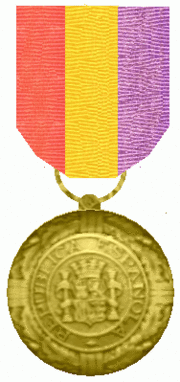Spanish Republican government in exile facts for kids
Quick facts for kids
Government of the Spanish Republic in exile
Gobierno de la República Española
en el exilio |
|||||||||
|---|---|---|---|---|---|---|---|---|---|
| 1939–1977 | |||||||||
|
|
|||||||||
|
Motto: Plus Ultra
"Further Beyond" |
|||||||||
|
Anthem: Himno de Riego
"Anthem of Riego" |
|||||||||
| Status | Government in exile | ||||||||
| Capital | Madrid Capital in exile: Paris (1939-1940/1946-1977) Mexico City (1940-1946) |
||||||||
| Common languages | Spanish | ||||||||
| Government | Multi-party Republic | ||||||||
| President | |||||||||
|
• 1939–1940 (first)
|
Diego Martínez Barrio | ||||||||
|
• 1970–1977 (last)
|
José Maldonado Gonzalez | ||||||||
| Prime Minister | |||||||||
|
• 1939–1945 (first)
|
Juan Negrín | ||||||||
|
• 1971–1977 (last)
|
Fernando Valera Aparicio | ||||||||
| Historical era | Interwar period / Cold War | ||||||||
|
• Established
|
4 April 1939 | ||||||||
|
• Disestablished
|
1 July 1977 | ||||||||
| ISO 3166 code | ES | ||||||||
|
|||||||||
The Government of the Spanish Republic in exile was a group of leaders from the Second Spanish Republic. They continued to act as the government even after they were forced to leave Spain. This happened after Francisco Franco's forces won the Spanish Civil War in 1939.
A "government in exile" is when a country's government has to leave its own land. They then set up their operations in another country. This government in exile lasted until Spain became a democracy again in 1977.
Contents
History of the Exile Government
After the Republic lost the war in April 1939, its leaders had to leave Spain. The President, Manuel Azaña, and the Prime Minister, Juan Negrín, went to France. President Azaña later resigned and passed away in November 1940.
Diego Martínez Barrio became the new President. He had been Prime Minister before. When France was taken over during World War II, the government moved again. They went to Mexico, because Mexico's President, Lázaro Cárdenas, still supported the Republic. Prime Minister Negrín, however, spent the war years in London. He resigned in 1945, and José Giral took over.
Hopes After World War II
Until 1945, the exiled Spanish leaders hoped for a big change. They thought that after World War II ended, the winning Allies would remove Franco from power. This would allow them to return to Spain and restart the Republic.
However, their hopes did not come true. Franco's government stayed in power. Because of this, the government-in-exile became more of a symbol. It no longer had much real power. In 1946, the government moved back to Paris. There were also other Spanish governments in exile, like the Basque and Catalan ones.
International Recognition
Right after World War II, some countries recognized this exiled government. These included Mexico, Panama, Guatemala, and Venezuela. Countries like Poland, Czechoslovakia, Hungary, Yugoslavia, Romania, and Albania also recognized them.
However, powerful countries like the United States, the United Kingdom, France, and the Soviet Union did not recognize them. This made it harder for the exiled government to have a strong impact.
The End of the Exile
In 1975, Franco passed away. King Juan Carlos then began to bring democracy back to Spain. By 1977, the exiled Republican leaders agreed to accept the new monarchy. They recognized King Juan Carlos's government as the true government of Spain.
A very important moment happened when Socialist leaders Felipe González and Javier Solana met King Juan Carlos. This meeting showed that the Socialists, who were strong supporters of the Republic, now accepted the monarchy. On July 1, 1977, the Government of the Spanish Republic in exile officially ended. King Juan Carlos welcomed the exile leaders in Madrid as a sign of peace and unity.
Presidents in Exile
| # | Portrait | Coat of arms | Name | President From | President Until | Political Party |
|---|---|---|---|---|---|---|
 |
 |
Diego Martínez Barrio Interim |
March 3, 1939 | May 11, 1940 | Republican Union | |
 |
Álvaro de Albornoz y Liminiana Interim |
May 11, 1940 | August 17, 1945 | Independent | ||
| 1 |  |
 |
Diego Martínez Barrio | August 17, 1945 | January 1, 1962 | Republican Union |
| 2 |  |
 |
Luis Jiménez de Asúa | January 1, 1962 | November 16, 1970 | Spanish Socialist Workers' Party |
| 3 |  |
 |
José Maldonado Gonzalez | November 16, 1970 | July 1, 1977 | Republican Left |
Prime Ministers in Exile
Spanish Republican Government in Exile (1939–1977)
| Portrait | Name (Birth–Death) |
Term of office | Political Party | President (Term) |
|||
|---|---|---|---|---|---|---|---|
| Took office | Left office | Days | |||||
| Juan Negrín (1892–1956) |
31 March 1939 | 17 August 1945 | 2331 | Spanish Socialist Workers' Party | Álvaro de Albornoz (1939–1945) |
||
 |
José Giral (1879–1962) |
17 August 1945 | 9 February 1947 | 541 | Republican Left | Diego Martínez Barrio (1945–1962) |
|
 |
Rodolfo Llopis (1895–1983) |
9 February 1947 | 8 August 1947 | 180 | Spanish Socialist Workers' Party | ||
| Álvaro de Albornoz (1879–1954) |
8 August 1947 | 13 August 1951 | 1558 | Republican Union | |||
 |
Felix Gordón (1885–1973) |
13 August 1951 | 17 April 1960 | 3170 | Republican Union | ||
 |
Emilio Herrera (1879–1967) |
17 April 1960 | 28 February 1962 | 682 | Independent | ||
 |
Claudio Sánchez-Albornoz (1893–1984) |
28 February 1962 | 28 February 1971 | 3287 | Republican Union | Luis Jiménez de Asúa (1962–1970) |
|
 |
Fernando Valera (1899–1982) |
28 February 1971 | 21 June 1977 | 2305 | Republican Union | José Maldonado Gonzalez (1970–1977) |
|
See also
 In Spanish: Segunda República española en el exilio para niños
In Spanish: Segunda República española en el exilio para niños




